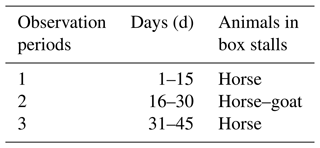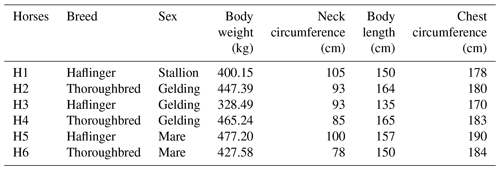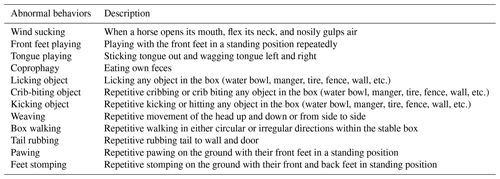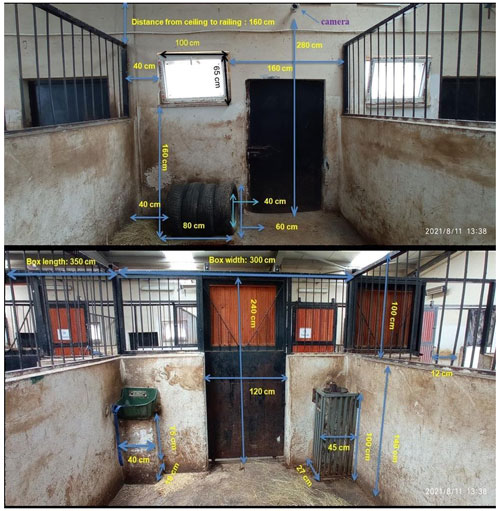the Creative Commons Attribution 4.0 License.
the Creative Commons Attribution 4.0 License.
The effect of being housed with a goat on abnormal behavior in horses
Fatih Yildirim
Ahmet Yildiz
Mahir Murat Cengiz
Murat Temel
Ayşe Küreksiz
Horses in stalls generally remain in single-stall housing, so abnormal behavior can be observed in this management condition. Abnormal behavior can harm the horse's keeper, rider, or even the animal itself. The present study aims to examine the effect of goats on abnormal behaviors in horses. For this purpose, it placed six horses and six goats in the single-stall housing of the horses, one horse and one goat, and monitored them for 45 d. The research was divided into three observation phases during this time: in the first observation, the horses were left alone (0–15 d), in the second observation, the horses were left together with the goats (16–30 d), and in the third observation, the horses were left alone again (31–45 d). In the first of these three stages, 12 different abnormal behaviors were detected in horses. The determined hours (00:00–01:00, 06:00–07:00, 07:00–08:00, 19:00–20:00, 20:00–21:00, 23:00–24:00 LT) of the day for abnormal behaviors identified in six different single-stall houses were examined. The frequency of the total abnormal behavior occurring at these hours was evaluated with nonparametric statistical tests. At the end of the research, front feet playing (p=0.002), crib-biting objects (p<0.001), and box walking (p<0.001) behaviors were significantly affected positively by the goats, while there was no statistical difference in other abnormal behaviors (p>0.05). In conclusion, it can be said that goats positively affect some abnormal behaviors in horses but not others.
- Article
(1433 KB) - Full-text XML
- BibTeX
- EndNote
It is important to know the behaviors of animals in breeding to provide the most suitable environmental conditions for animals. Behavior is expressed as a change in state that occurs in all or part of an animal's body. Since animal behavior is in close relationship with the environment, it can also be defined as the animal's reaction to its environment (Özbeyaz and Akçapınar, 2006).
Behavior is a way of adapting to and controlling their environment for most animals (Kappeler, 2010). Difficulties in performing these behaviors may result in maladaptive behaviors such as stereotypical behaviors (Hart et al., 2009). When examining the general behavior of the wild animal population, there is no stereotypical behavior; therefore, it is considered abnormal and undesirable. In addition, the abnormal behavior is believed to be demonstrated by the animal's state of being stressed, bored, or frustrated because of the suboptimal condition of the housing. And it could also be a clinical symptom of central nervous system dysfunction (McBride and Hemmings, 2009; Roberts et al., 2017).
In animal husbandry, unsuitable care and feeding conditions can cause abnormal behavior in animals. Abnormal behaviors observed in horses consist of a series of undesirable, useless, and repeated bad habits (Inal et al., 1999; Gill et al., 2005; McAfee et al., 2002). These abnormal behaviors can be categorized into four groups: abnormal movements in nutrition, in movement, in social, and in comfort behaviors (Hacan and Akçapınar, 2013). Abnormal behaviors related to eating include crib gnawing, wind sucking, bar biting, wood chewing (Gill et al., 2005; Inal et al., 1999), tongue wriggling, rubbing the teeth against bars and bar biting, licking stereotypical objects, eating manure and soil, and overeating (Zeitler-Feicht, 2004). Abnormal behaviors related to exercise include stall walking, fence walking, figure-eight walking, excessive pawing, and stereotypical kicking against stall walls (Zeitler-Feicht, 2004). Abnormal behaviors related to social behaviors include abnormal social imprinting, self-mutilation, and increased aggression (Zeitler-Feicht, 2004). Abnormalities related to comfort are stereotypical tail rubbing, stereotypical head tossing, and shaking head (Zeitler-Feicht, 2004).
Some of the horses' abnormal behaviors are defined as stereotypical behaviors. The behavior is described by its predictability and nature of repetition (Mason, 1991; Sarrafchi and Blokhuis, 2013). The stereotypical behavior of horses is generally classified into two main forms: oral and locomotor (Sarrafchi and Blokhuis, 2013; Roberts et al., 2017). Sham chewing, licking, lip smacking, tongue rolling, and crib biting/wind sucking are examples of oral stereotypical behavior; weaving, pawing, box walking, and head tossing/nodding are examples of locomotor stereotypical behavior (Hanis et al., 2020). The most common locomotory stereotypical behavior reported in horses is weaving, whereas wind sucking, licking, and crib biting are also common oral stereotypical behaviors (Sarrafchi and Blokhuis, 2013).
Boredom, irritability, or a lack of work and interest due to not meeting the needs and desires of the horses may cause many of the abovementioned abnormal behaviors in the horses housed in individual quarters (Boyd, 1988; Krzak et al., 1991; McGreevy, 2003). Horses are social animals, and thereby they demand constant attention and seek company by others. Some researchers used mirrors to relieve boredom in some horses and discovered that having the horses see each other in mirrors helped prevent abnormal behavior (Inal et al., 1999; Evans, 2000; Gill et al., 2005; Özbeyaz and Akçapınar, 2006). Therefore, providing the companionship of other animals or creating environments that do not harm horses will further their welfare.
Although it exhibits a wide range of behaviors, the domesticated goat has been the subject of relatively few behavioral studies (Miranda-de la Lama and Mattiello, 2010). Goats are gregarious and social animals, and a stable social environment may promote their adaptation to the environment through social learning and welfare conditions, as evidenced by their reduced responsiveness to stressful events (Napolitano et al., 2018). It has been previously reported that goats try to communicate with people in the same manner as domesticated animals such as dogs and horses (Kaminski et al., 2005; Nawroth et al., 2016). Also, the researchers believe that a better understanding of human–goat interaction could offer an overall improvement in the animals' welfare (Fowler, 2008).
If we better understand a horse's normal behaviors, it will become much easier to identify abnormal ones. Completely isolating horses from the environment or from a social environment can lead to the development of undesirable problems (Landsberg and Denenberg, 2019). For this reason, it was ensured that the horses had contact with the goats, and it was attempted to reduce the amount of time that the horses displayed abnormal behavior.
In the literature, no scientific research has been found to show that housing a horse with a goat prevents the abnormal behavior of horses. However, both on the internet and according to some horse breeders, there is a friendship between horse and goat, and even goats reduce the abnormal movements of horses. Therefore, the present study aimed to provide the first report on the recovery of abnormal behaviors in the case of a relationship between a horse and a goat in a box stall. Another inference of this research was to reduce the idle time of horses by keeping them in contact with the goats and to prevent them from demonstrating abnormal behaviors. In line with all this literature, reviews, and observations, the hypothesis of this research is that goats will prevent the abnormal behavior of horses.
2.1 Study design
The study consisted of three observation periods of 15 d each. Horses alone in the first stage, horses with goats in the second stage, and horses alone in the third stage. As a result, abnormal behaviors were observed in observation 1. In observation 2, the situation with the goats next to the horses was monitored to see if there was any change. When the horses moved away from the goats in observation 3, it was observed whether abnormal behaviors returned. Table 1 shows the days and animals involved in the process of observing the camera recordings of horses and goats.
2.2 Animals and management
A total of six Thoroughbred (three) and Haflinger (three) horses ranging in age from 9 to 20 years were included in the study. Breeds, sex, body weight, and some of the body measurements of the horses used in the study are given in Table 2. The animals were given concentrate and roughage at 09:00 and 18:00 LT. A daily diet of 1–2 kg of roughage and 0.5–1 kg of concentrated feed per 100 kg of body weight was provided. In addition, six female hair goats (6 months old) were used in the study. The goats were also given concentrate and roughage to meet their daily food requirements. The litter of the animals in the study was cleaned every day at 08:00 LT in the morning. In addition, clean water was kept in front of them at all times for the horses and goats to drink. Researchers and riders observed the health of the horses and goats. The animals remained healthy during the whole experiment. The horses used in the study were housed in the same stable, so environmental factors affecting them were similar.
2.3 The abnormal horse behaviors
In this study, 12 most common abnormal behaviors were monitored throughout the research. The abnormal behaviors examined and their definitions are shown in Table 3.
2.4 The test arena
The study was carried out in six box stalls inside the barn, surrounded by walls. The horse barn, where the horses were, 9.5 m wide and 19.5 m long. The width of the corridor (alley) in the middle of the barn was measured at 2.8 m. The starting point of the roof over the wall of the barn is 4 m, and the middle highest point is 6 m. The individual box stalls in the barn where the research was carried out are approximately 3×3.5 m2. During the periods when the goats (all six goats) were separated from the horses, they were housed in one of these empty box stall areas. The other six boxes were occupied by one horse each. The test areas (Fig. 1), where the horses stayed, were individually enclosed within the barn and were previously used by the horses. In the study, observations were made from single cameras located in individual box stalls. The test arenas were enclosed in the barn and well known to the horses.
2.5 Accustoming goats to horses
When the goats used in the research were first brought to the barn, they were accustomed to the barn for 15 d in a box stall isolated from the horses. Then, horses and goats were accustomed to each other gradually. The program was like this: 15 min on the first day, 30 min on the second day, 60 min on the third day, and 12 h on the fourth day under human control. After the goats were accustomed to the horses, they were allowed to stay with the horses for 15 d (16–30 d), which was the second observation phase of the study. In the study, one horse stayed with a goat while the goats and horses were together. Each time, the same goat was placed side by side with the same horse. Except for the recording hours (19:00 to 08:00 LT) taken for the detection of abnormal behaviors, the goats were kept together in their box stalls (08:00 to 19:00 LT).
2.6 Camera, recording system, and data collection
In this research, one camera was used (six cameras for a total of six individual box stalls) to observe the behavior of each horse in the box, as well as one recording device that recorded the cameras (Hikvision, Copyright Hikvision). At the beginning of the research, the camera recording system recorded the paddocks for 24 h a day for 30 d. Among the records examined, it was concluded that it was more appropriate to conduct the study between 19:00 and 08:00 LT. At this time, it was observed that the effect of the environment on the behavior of the horses was minimal. It was observed that factors such as the feeding of the horses outside of working hours, someone entering the barn, or being exposed to different activities such as training affected their behavior in different ways. For this reason, the following 1 h intervals were used to study the effect of the goats because of the higher number of observations of abnormal behavior during these times: 00:00–01:00, 06:00–07:00, 07:00–08:00, 19:00–20:00, 20:00–21:00, and 23:00–24:00 LT.
In this study, three observation periods of 90 h each, for a total of 270 h, were used to monitor the abnormal behavior of each horse. In this case, 1620 h (45 d × 6 h d−1 × 6 animals) of behavioral recordings were monitored with the media player classic using the human eye. The definitions of the behaviors were made clear to avoid ambiguity between the observer and the interpretation.
2.7 Statistical analysis
The research data monitored from the camera recordings were accepted as the number of observed abnormal behaviors. In other words, the number of times a movement was repeated was counted individually, and the value found was written numerically. The IBM SPSS statistical program for Windows was used to evaluate all the data acquired from animals in the study (Version 20, IBM Corp., Armonk, NY, USA). In this program, the related sample test, one of the nonparametric tests, was performed on the observation groups (Observations 1–2–3). This test was conducted considering the daily frequency of abnormal behaviors. When data were shown, they were presented as the median and minimum–maximum value. In addition, the Kruskal–Wallis test, one of the nonparametric tests, was used to show the differences in abnormal behaviors during the day. The different levels between observation groups were considered significant at p<0.05.
The differences between the observation periods of abnormal behaviors obtained from the study are given in Table 4. As a result of the observations, the abnormal behaviors of horses – repetitive front feet playing (p=0.002), crib-biting objects (p<0.001), and box walking (p<0.001) – were significantly affected by goats. However, there was no statistical difference in other abnormal behaviors of horses (p>0.05).
Table 4Consequences of abnormal behaviors in observation periods (median daily amount − min–max). The p values refer to the effect of difference between observation periods; within each row, different superimposed letters indicate significant differences between observation periods.
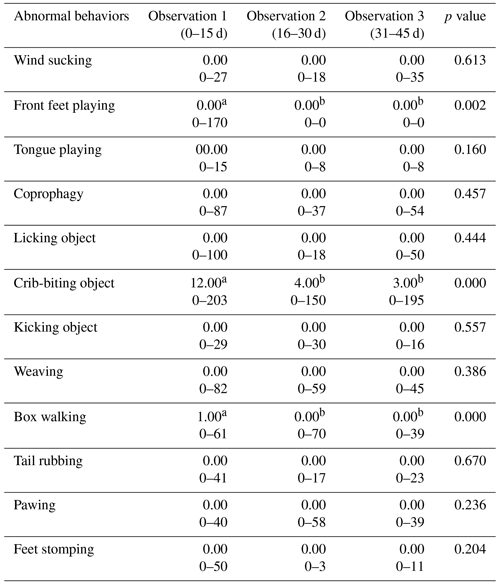
According to the results, the behavior of repetitive playing of front feet in a standing position was not observed at all over the next 30 d (Observations 2 and 3); when we placed the goats with the horses, it disappeared completely. The groups cribbing, biting any object, showing box walking, and having a statistically significant difference between them were examined. As a consequence of the examination, it was concluded that these behaviors decreased after the goats were placed but did not completely disappear.
When the frequency of abnormal behaviors during the day was examined, statistically significant (p<0.001) differences were detected (Fig. 2). It was observed that some abnormal behaviors were performed more intensely than others. In particular, the crib-biting object behavior attracted attention as the most intense behavior.
The present study is the first report on the influence of goats on the abnormal behaviors of horses in box stalls. For many racehorse breeders, keeping horses in individual stable boxes is common practice for performance horses such as racehorses (Munoz et al., 2014, 2018). Only a small number of horses were kept in loose housing systems or paddocks (Leme et al., 2014; Larsson and Müller, 2018). All six box stalls selected in the present study housed their horses in separate stable boxes, similar to previous studies (Normando et al., 2002; Hockenhull and Creighton, 2010; Leme et al., 2014; Hanis et al., 2020).
Horses predominantly remain housed in single stalls. One of the main reported reasons is the fear that they will become agitated and injure themselves, thereby impairing their performance if released into paddocks. Growing scientific evidence shows that single-stall housing has negative consequences for horses' welfare. Social contacts are crucial, and also for sport horses, some time for daily free locomotion (ideally with roughage/grass resources) is possible, incurs no particular risks, and is an essential requisite for promoting good welfare for horses (Lesimple et al., 2020). In this study, we utilized goats for the socialization of horses, and we found that abnormal behaviors such as front feet playing, crib-biting objects, and box walking were significantly reduced.
Abnormal behaviors in horses have been linked to practices such as stabling, minimal social contact, and diets with low forage (McGreevy et al., 1995a; Bachmann et al., 2003). Behaviors such as box walking, crib biting, and weaving are also associated with stabling (Nicol, 1999). Cribbing is among the best-known handling and management-induced behavioral abnormalities of horses. Depending on use, management, and breeding, it has been estimated that between 1 % and 8 % of all horses are crib bitters (Zeitler-Feicht, 2004). Crib biting was the most frequent abnormal behavior observed in this study, whereas another study observed that wood chewing, weaving, and licking were the most frequent, and crib biting and wind sucking were the least frequent (Leme et al., 2014). As cribbing is a residual-reactive behavioral aberration, success in treatment is relatively rare because of a resistance to therapy. A similar genesis to cribbing is assumed for both tongue playing and licking object behaviors. But these behaviors can be prevented by appropriate management, feeding, and handling. These have to be optimized from birth because mistakes made during early development are particularly likely to make horses predisposed to cribbing (Zeitler-Feicht, 2004). In this study, the frequency of abnormal behaviors varied according to goat use, which seems to be explained by differences in synergy, especially housing. Also, it was found that when goats and horses were housed side by side, crib-biting objects, box walking, and front feet playing were significantly reduced. It is a remarkable result that the abnormal behavior of the front feet disappeared completely after housing goats and horses together.
As observed in the present study, it can be observed that horses kick some objects. Constant, stereotypical kicking against the stall walls with the front or rear hooves (“stall kicking”) is only observed in stalled horses (Zeitler-Feicht, 2004). In this study, this situation did not change when the horses were kept together with the goats in the stall, and the horses continued to kick.
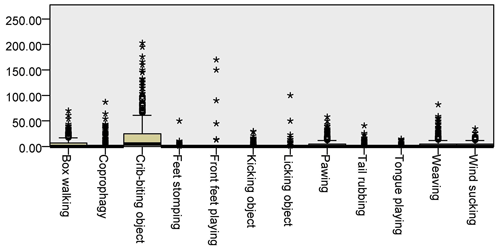
Figure 2Frequency of abnormal behavior during observations. The data points shown are the results of repeated observations made by the six horses during the study period.
Manure and soil eating is observed in adult horses; it most frequently represents a deficiency-induced behavioral aberration. The most common causes are a nutritional deficiency or an insufficient satisfaction of an eating need (Zeitler-Feicht, 2004). Because a balanced diet was prepared, no coprophagy state was observed in the horses in this study. Studies of the abnormal behavior of horses on food have examined the effects of the frequency, amount, or content of the nutrients given to the animals (Willard et al., 1977; McGreevy et al., 1995a; Elia et al., 2010; Larsson and Müller, 2018; Hanis et al., 2020). Some of these studies indicated that the high number of feedings per day was found to have a significant influence on locomotor stereotypes and redirected behaviors. This is presumably because the concentrates were offered more constantly and in larger quantities than hay. Feeding with forage more than three times a day was judicious, as it could reduce the pitfalls of oral stereotypical actions (McGreevy et al., 1995b). To support this, Arabian horses in Sweden were fed hay more frequently (four or more times per day) than concentrated feed (one to two times per day), which has a positive effect on preventing stereotypical behavior (Larsson and Müller, 2018). A study reported that horses masticated hay more than concentrate (Elia et al., 2010). In a study of foals, offering higher amounts of low-energy feed to foals reduced the risk of abnormal behavior (Parker et al., 2008). However, in this study, the research was carried out without changing the amount and frequency of feed given to the horses, and the effect of goats on abnormal behavior was tried to be revealed. As a result, changing the amount and frequency of feed given to animals can affect the abnormal behaviors studied in the study.
Weaving is one of the most common abnormal behaviors in horses, affecting between 1 % and 9.5 % of all horses, depending on breed, management system, and way of use (Zeitler-Feicht, 2004). Also, Hanis et al. (2020) found weaving (4.19 %) to be the most common locomotory stereotypical behavior exhibited by horses. In the present study, the daily level of weaving was ranked third among abnormal movements. A certain decrease was observed in this abnormal movement when the goat was placed next to the horses, but this situation was not statistically significant (p>0.05). In addition, in the findings of some researchers, the intensity of daily weaving was observed 3–15 times (Radtke, 1985), while it was observed 0–82 times in the actual study. In other words, in our study, there were horses that did not make any weaving movements, and there were horses that showed a lot of weaving according to the studies of other researchers.
The sporadic tail rubbing observed in horses is normal equine behavior in the context of grooming alone. In contrast, stereotypical or longer-lasting tail rubbing should be considered abnormal behavior towards objects (Zeitler-Feicht, 2004). As a result of this study, it can be accepted as the normal movement of horses since there was not much tail rubbing observed.
The results of researchers on the prevalence of box walking and pawing showed 0–4 times (2.1 %) and 0–3 times (1.14 %), respectively (Hanis et al., 2020). The daily box walking and pawing incidences of abnormal behaviors in the current study, which were 0–61 and 0–40 times at the start, decreased to 0–39 and 0–39 times with the effect of goats, respectively. For horses such as refined warmbloods and thoroughbreds, in particular, relaxation of the daily routine in this manner is of great importance (Zeitler-Feicht, 2004). A horse may stomp when it is impatient. Feet stomping is often seen when a horse has been tied up at feed time. Repeated stomping can quickly turn into pawing. This state expresses its impatience, and the horse normally does it to attract attention. In this study, it is thought that goats contributed to the reduction of abnormal behaviors in these horses, i.e., to their relaxation.
Horses are highly social animals, so they need contact with others for normal daily care and well-being. Isolating horses can lead to the development of problems. In this research, contact between goats and horses was ensured, their idle time was reduced, and they showed fewer abnormal behaviors as a consequence of these regulations.
In the prevention of abnormal behavior in horses, improvement of the management and handling conditions has to be the first therapeutic measure. In other words, methods that will make the horses feel comfortable should be preferred. The goats had a positive effect on the abnormal behaviors of horses, including front foot playing, crib-biting objects, and box-walking behaviors, while others were unaffected. The co-housing of horses with goats reduced the abnormal movements of horses in general. During the research, however, it was discovered that the goats had trouble responding to the horses' movements or reactions in order to play with them or have fun with them. As a result, while employing goats to repair abnormal behaviors in horses, the horse's reactions to the goat should be analyzed, and they should be kept together according to the outcome. Nonetheless, further research is needed to determine this relationship between horses and goats.
The data used and analyzed during this study are available from the corresponding author upon reasonable request.
All the authors contributed to the work described in the paper. FY, AY, MMC, and MT designed the experiment and performed it on the farm. FY and AK assessed the camera records; FY analyzed the data statistically. FY, AY, and MMC wrote the paper; FY and AY corrected the manuscript during the editorial process.
The contact author has declared that none of the authors has any competing interests.
All experimental procedures were approved by the Ethics Committee in Research with Production Animals of the Veterinary Faculty at the Atatürk University of Türkiye according to process number 2020/4. The animals were housed at the Horse Breeding Center of Atatürk University.
Publisher’s note: Copernicus Publications remains neutral with regard to jurisdictional claims in published maps and institutional affiliations.
This research has been supported by the Atatürk Üniversitesi (grant no. TSA-2020-8397).
This paper was edited by Christian Nawroth and reviewed by two anonymous referees.
Bachmann, I., Bernasconi, P., Herrmann, R., Weishaupt, M. A., and Stauffacher, M.: Behavioural and physiological responses to an acute stressor in crib-biting and control horses, Appl. Anim. Behav. Sci., 82, 297–311, https://doi.org/10.1016/S0168-1591(03)00086-8, 2003.
Boyd, L. E.: Time budget of adult prezewalski horses: Effects of sex, reproductive status and enclosure, Appl. Anim. Behav. Sci., 21, 19–39, https://doi.org/10.1016/0168-1591(88)90099-8, 1988.
Elia, J. B., Erb, H. N., and Albro, K.: Motivation for hay: Effects of a pelleted diet on behavior and physiology of horses, Physiol. Behav., 101, 623–627, https://doi.org/10.1016/j.physbeh.2010.09.010, 2010.
Evans, J. W. (Ed.): Horses. A guide to selection, care, and enjoyment, 3rd Edn., Henry Holt and Company, New York, ISBN: 978-0-8050-7251-8, 2000.
Fowler, M. E. (Ed.): Restraint and Handling of Wild and Domestic Animals, Wiley-Blackwell, 488 pp., ISBN: 978-0-813-81432-2, 2008.
Gill, W., Meadows, D. G, and Neel, V. B.: Understanding horse behaviour, Agricultural Extension service, Institute of Agriculture, 4-H Member Guide, Unit 8, Grade 12, Tenessee, 2005.
Hacan, Ö. and Akçapınar, H.: Behaviour of horse, Lalahan Hay. Araşt. Enst. Derg., 53, 47–57, 2013.
Hanis, F., Chung, E. L. T., Kamalludin, M. H., and Idrus, Z.: The influence of stable management and feeding practices on the abnormal behaviors among stabled horses in Malaysia, J. Equine Vet. Sci., 94, 103–230, https://doi.org/10.1016/j.jevs.2020.103230, 2020.
Hart, P. C., Bergner, C. L., Dufour, B. D., Smolinsky, A. N., Egan, R. J., and Laporte, J. L.: Analysis of abnormal repetitive behaviors in experimental animal models, edited by: Warnik, J. E. and Kauleff, A. V., Transl. Neurosci., Its Adv. Anim. Res. Ethics., New York, Nova Science Publishers, 72–82, ISBN: 978-1-60876-185-2, 2009.
Hockenhull, J. and Creighton, E.: Unwanted oral investigative behaviour in horses: A note on the relationship between mugging behaviour, hand-feeding titbits and clicker training, Appl. Anim. Behav. Sci., 127, 104–107, https://doi.org/10.1016/j.applanim.2010.08.008, 2010.
Inal, Ş., Tekeş, M. A., and Dere, S.: Atlarda davranış problemleri, 1. Ulusal Atçılık Sempozyumu, Konya, Türkiye, 1999.
Kaminski, J., Riedel, J., Call, J., and Tomasello, M.: Domestic goats, Capra hircus, follow gaze direction and use social cues in an object choice task, Anim. Behav., 69, 11–18, https://doi.org/10.1016/j.anbehav.2004.05.008, 2005.
Kappeler, P. (Ed.): Animal behaviour: Evolution and Mechanisms, Springer, Berlin, ISBN: 978-3642026232, 2010.
Krzak, W. E., Gonyou, H. W., and Lawrence, L. M.: Wood chewing by stabled horses: Diurnal pattern and effects of exercise, J. Anim. Sci., 69, 1053–1058, 1991.
Landsberg, G. M. and Denenberg, S.: Behavior problems in horses, MSD Veterinary Manual, Merck Sharp, and Dohme Corp, a subsidiary of Merck and Co., Inc., Kenilworth, NJ, USA, Merck & Co., NJ, USA, 2019.
Larsson, A. and Müller, C. E.: Owner reported management, feeding and nutritionrelated health problems in Arabian horses in Sweden, Livest. Sci., 215, 30–40, https://doi.org/10.1016/j.livsci.2017.03.001, 2018.
Leme, D. P., Beatriz, A., Parsekian, H., Kanaan, V., and Jose, M.: Management, health, and abnormal behaviors of horses: A survey in small equestrian centers in Brazil, J. Vet. Behav., 9, 114–118, https://doi.org/10.1016/j.jveb.2014.01.004, 2014.
Lesimple, C., Reverchon-Billot, L., Galloux, P., Stomp, M., Boichot, L., Coste, C., and Hausberger, M.: Free movement: A key for welfare improvement in sport horses?, Appl. Anim. Behav. Sci., 225, 104972, https://doi.org/10.1016/j.applanim.2020.104972, 2020.
Mason, G. J.: Stereotypies: a critical review, Anim. Behav., 41, 1015–1037, https://doi.org/10.1016/S0003-3472(05)80640-2, 1991.
McAfee, L. M., Mills, D. S., and Cooper, J. J.: The use of mirrors for the control of stereotypic weaving behaviour in the stabled horse, Appl. Anim. Behav. Sci., 78, 159–173, 2002.
McBride, S. and Hemmings, A. A.: A Neurologic perspective of equine stereotypy, J. Equine Vet. Sci., 29, 10–16, https://doi.org/10.1016/j.jevs.2008.11.008, 2009.
McGreevy, P.: Notes on some topics in applied animal behaviour, PhD, School of Veterinary Science University of Queensland, Australia, 2003.
McGreevy, P. D., Cripps, P. J., French, N. P., Green, L. E., and Nicol, C. J.: Management factors associated with stereotypic and redirected behaviour in the Thoroughbred horse, Equine Vet. J., 27, 86–91, 1995a.
McGreevy, P. D., French, N. P., and Nicol, C. J.: The prevalence of abnormal behaviours in dressage, eventing and endurance horses in relation to stabling, Vet. Rec. Open., 137, 36–37, 1995b.
Miranda-de la Lama, G. C. and Mattiello, S.: The importance of social behaviour for goat welfare in livestock farming, Small Rumin. Res., 90, 1–10, https://doi.org/10.1016/j.smallrumres.2010.01.006, 2010.
Munoz, A. L., Ainardi, C. F., Rehhof, V. C., Cruces, L. J., Ortiz, R. R., and Briones, L. M.: Prevalence of stereotypies in thoroughbred race horses at Club Hípico Concepcion, Chile, Prevalencia de estereotipias en caballos fina sangre de carrera del, Rev. MVZ Cordoba, 19, 4259–4268, 2014.
Munoz, L., Leon, C., Cruces, J., Ortiz, R., and Briones, M.: Locomotor stereotypies and racing performance in thoroughbred horses, J. Vet. Behav., 25, 24–27, https://doi.org/10.1016/j.jveb.2018.03.006, 2018.
Napolitano, F., Serrapica, M., Braghieri, A., Claps, S., Serrapica, F., and De Rosa, G.: Can we monitor adaptation of juvenile goats to a new social environment through continuous qualitative behaviour assessment?, Plos One, 13, e0200165, https://doi.org/10.1371/journal.pone.0200165, 2018.
Nawroth, C., Brett, J. M., and McElligott, A. G.: Goats display audience-dependent human-directed gazing behaviour in a problem-solving task, Boil. Lett., 12, 20160283, https://doi.org/10.1098/rsbl.2016.0283, 2016.
Nicol, C. J.: Stereotypies and their relation to management, in: Proceedings of the 38th British Equine Veterinary Association Congress, Harrogate, 122–123, Bristol Veterinary School, 1999.
Normando, S., Canali, E., Ferrante, V., and Verga, M.: Behavioral problems in Italian saddle horses, J. Equine Vet. Sci., 22, 117–120, https://doi.org/10.1016/S0737-0806(02)70123-8, 2002.
Radtke, K.: Über die Bewegungsstereotypie Weben beim Pferd, München, Diss. Med. Vet., 1985.
Roberts, K., Hemmings, A. J., McBride, S. D., and Parker, M. O.: Causal factors of oral versus locomotor stereotypy in the horse, J. Vet. Behav., 20, 37–43, https://doi.org/10.1016/j.jveb.2017.05.003, 2017.
Özbeyaz, C. and Akçapınar, H.: At yetiştiriciliği ders notları, Ankara University, Faculty of Veterinary Medicine, Anim. Sci. J., Ankara, 2006.
Parker, M., Goodwin, D., and Redhead, E. S.: Survey of breeders' management of horses in Europe, North America and Australia: comparison of factors associated with the development of abnormal behaviour, Appl. Anim. Behav. Sci., 114, 206–215, https://doi.org/10.1016/j.applanim.2008.02.003, 2008.
Sarrafchi, A. and Blokhuis, H. J.: Equine stereotypic behaviors: Causation, occurrence, and prevention, J. Vet. Behav. Clin. Appl. Res., 8, 386–394, https://doi.org/10.1016/j.jveb.2013.04.068, 2013.
Willard, J. G., Willard, J. C., Wolfram, S. A., and Baker, J. P.: Effect of diet on cecal pH and feeding behavior of horses, J. Anim. Sci., 45, 87–93, 1977.
Zeitler-Feicht, M. H. (Ed.): Horse Behaviour Explained, Manson Publishing, Germany, Taylor & Francis Group, 2004.






